AFTERNOON ON A HILL
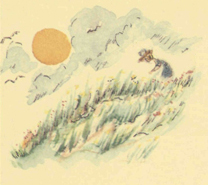
I will be the gladdest thing
Under the sun!
I will touch a hundred flowers
And not pick one.
I will look at cliffs and clouds
With quiet eyes,
Watch the wind bow down the grass,
And the grass rise.
Edna St. Vincent Millay
Millie Heckman Huffaker was raised on a ranch in Exeter, Tulare County, California, in the early 1900s. “We always had to make our own amusements and toys,” she said, “and we always seemed to have plenty to do. The toys that were my favorites were my grass screechers.
“You pick a piece of Johnson grass and hold it between your thumb and first finger on each hand…like so. Pull it tight, hold it on its edge, and blow.” Millie blew, and grinned from ear to ear; it was the first time she had tried it in sixty years. “You can make different sounds and screeches and whistles, depending how you breathe and blow. You can really get good at it and play tunes and fool people.”
First take a willow bough,
Smooth and round and dark,
And cut a little ring
Just through the outside bark.

Then tap and rap it gently
With many a tap and pound,
To loosen up the bark,
So it may turn round.
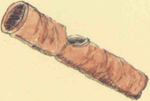
Slip the bark off carefully,
So that it will not break,
And cut away the inside part.
And then a mouthpiece make.

Now put the bark all nicely back,
And in a single minute
Just put it to your lips,
And blow the whistle in it!
Anonymous

John Arnold of Kokomo, Indiana, was famous for his walnut sailing vessels back in the 1940s. He’d fill a halved walnut with sap, glue, mud, or a gumdrop and stick in a toothpick, twig, or matchstick for a mast. Either a leaf or piece of paper would suffice for a sail, and he would spend hours sailing his fleet in Wildcat Creek, any rain-swollen gutter, or even Gram’s washtub. When John had a son, he found himself constructing walnut boats again and delighting not only his son and his young friends, but himself as well!
I once heard a story about a little girl who was very poor. Her birthday arrived and her family had no money to buy the sugar, flour, and eggs to bake her a cake. Missing out on a cake didn’t bother her, but she was heartbroken about not having candles to wish upon.
When suppertime arrived, the girl swallowed the lump in her throat and resolved not to cry. Dinner was very meager, white bread with lard, poke greens, and a pot of navy beans…without ham. The little girl bravely ate her dinner and bantered cheerfully with her brothers and sisters.
After the table was cleared, just about the time the cake should have been served, the lights went out without warning. Mother, father, and all of the children paraded into the room holding the huge old crockery mixing bowl filled with water and a flotilla of walnut boats. Inside each walnut boat (one for each year of her life) was a small birthday candle glowing brightly. The little girl closed her eyes tightly, made a wish, and blew so hard the little boats scudded around the edges of the bowl as each and every candle was extinguished.
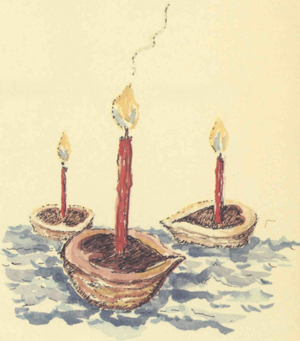
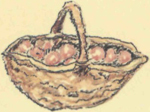
Sometimes the simplest of gifts can give the most joy. My friends David, Julee, and Summer Krause stopped by on Christmas Eve and delivered a tray of cookies and a beautifully decorated golden box. I couldn’t imagine what was inside. Jewelry? Really, there was nothing I needed.
On Christmas morning I eagerly unwrapped the gift from the Krause family and let out a shriek of excitement. Inside the box was a set of six tiny walnut baskets. Each basket was carved by David, and then Julee and Summer trimmed them with miniature tablecloths and tied the handles with small red bows. It looked like a perfect picnic ensemble for a family of mice.
Now, every year I fill the baskets with pearly pink berries and hang them from our Christmas tree.

Who could help being intrigued by acorns in their little caps? I still enjoy walking through the woods and stuffing my coat pockets full of them!

Pick freshly fallen acorns and run a toothpick or nail through the acorn cap and halfway into the acorn (you must pre-drill a hole). The acorn top game may be played alone or with a friend.
First you empty a tabletop and set some of your acorn tops spinning. They may bump into each other and spin off of each other, but this is part of the battle. If one spins off of the table he is the loser. Whoever spins longest on the table is the winner. Whole armies of acorn tops may be made and set to spinning at the same time. Flowers of a certain color can be impaled on each tip. Perhaps red geraniums could top one army and blue cornflowers top another. Whichever army has the most spinners at the end of the battle wins. It is a sight to see all of the tops wildly spinning with vivid colors!
This story was told to me by Dorothy Greeman Peterson, who grew up in Turner County, Georgia, on a 200-acre peanut farm.
“In the springtime we would make houses out of gourds for the martins, sparrows, and other birds to lay their eggs in and raise their young. It was a beautiful sight to watch those birds flutter around the gourd houses and build nests. And they made such beautiful music!
“To make gourd houses you take green gourds, cut holes in them the shape of windows and doors, big enough for a bird to get through, scrape out the seeds and pulp, and hang them up to dry. We would poke holes through the tops and run wires through so we could hang them from a gourd tree after they dried.
“It was so much fun to make the gourd houses and watch the goings on. In the South gourds grow wild, usually among the watermelons or on the side of the road. We used leftover gourds as dippers on the back porch: just cut the gourd in half and dig out the pulp and seed and let it dry out. Oh, but the birdhouses were my favorite.”

If you haven’t tried raising gourds you are missing a wonderful experience. Gourds provide a fragrant, fast growing shade screen, and the flowers are lovely. At Lewis Mountain Herbs in Ohio, a corner of the garden has a simple wooden framework totally covered with gourd vines and hung gaily with huge, ripening gourds. The gourds are harvested and dried for use as planters, birdhouses and other things, but during the summer the vines provide a delightful shady spot.
An old Burpee catalog for 1887 states, “Sugar trough gourds are useful for many household purposes such as buckets, baskets, nest-boxes, soap and salt dishes. They grow to hold from four to ten gallons each, have thick, hard shells, very light but durable, having been kept in use as long as ten years.” Dippers and birdhouses were made from the dipper gourd, spoons were made from the spoon gourd (or it was left whole to form a darning egg for stockings or to become a rattle for the baby because of the dried seeds inside). Dippers and spoons made from gourds had the advantage of handles that don’t get hot.
“A wonderful gourd toy that was often made in the late 1800s was a gourd man. He was simply stuck with twigs for arms and legs and a little face was painted or scratched on the top. But my favorite gourd toys were the coach gourds. An elongated gourd would have one quarter of the narrow part cut off so that it then resembled a coach shape. The pulp would be cleaned out and a long twig pushed through for an axle for the coach’s wheels. The wheels could be made of thin log rounds, sliced buckeyes, or slices of cucumber.
The horses were easy to make out of peanuts with twig legs and drawn-on faces. Long strands of grass were tied around the peanuts to hold the harness in place. Driving the coach could be a lovely flower lady or a peanut lady or even a corncob lady. Whoever drove it, the ride would be fun!
In the 1880s, a favorite flower lady doll was made of gourd flowers! Harvest the tiny gourd just as it begins to form. This will be the doll’s head. A gourd leaf is used as her clothing, and a hat can be made from another leaf. Twigs or toothpicks can be used to hold all of the parts of this lady together.

On a hot, clear, spring afternoon I was sitting on Georgie Van de Kamp’s veranda with a group of gardening friends. We were discussing gardens and things we remembered about gardens and Carol Bateman piped up, “We used to place bets on hops!”
“Bets on hops?” I asked, “What in the world do you mean?” Carol laughed and said that hops vines grow so fast you can almost see them climbing.
“During our family’s summers in Yosemite we would place bets on how much the hop vine would grow during the night,” she said. “In the morning, we would go out and measure and do you know that some nights it would actually grow 6 or 7 inches!”
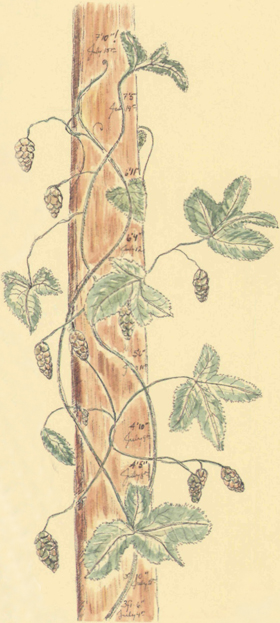

Thomas Stanley was in his late 70s when he told me the story of how he and his friends turned grass into hearts and fooled the girls. “We would pick a bunch of shepherd’s purse—you know how it has the flat seedpods that look like little hearts? Well, we would hide the hearts under our tongues. Then we would stand in front of the girls and pick a handful of grass and say, ‘We can chew grass and spit out hearts.’
“The girls would always laugh at us and tell us we couldn’t, whereupon we would gobble up the blades of grass and spit out the shepherd’s purse hearts. Got ’em every time!”
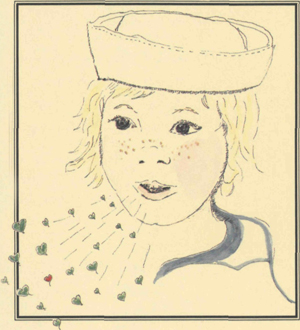
Margaret Crittenden Sparks told me this story about growing up in Topeka, Kansas, in the 1920s. “Grandma always said that summers in Topeka were so hot and the air so thick and heavy that the wheat could stand up on its own after it was cut.
“Playing out in the sunshine or in the house was unbearable. It seemed as though we spent all of our time on the huge front porch which was draped and shaded by an old trumpet vine.
“My sisters and brothers and I had mixed up a bucket of soap flakes and water. We were planning to spend the day blowing bubbles, but much to our dismay we could find only one bubble pipe.
“For some reason, our eyes all seemed to settle on the red trumpet flowers at the same time. We each picked one, pulled out the stamens to create a little hole, pinched the hole closed, poured in the soapy water, tilted the blossom up, and blew from the wide part of the petals. It worked perfectly! We never argued over the bubble pipe again—we had an unlimited supply!”
"we spent all of our time on the huge front porch which was draped and shaded by an old trumpet vine."
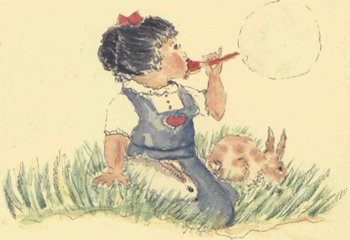
This story was related to me in the early 1970s. Mammy is no longer living, but her story is as delightful today as when I first heard it.
“When we were little kids in Alabama we just didn’t have any money or any toys like kids have now. We had to make all our own fun and mischief—and we did! Let me tell you the pumpkin patch story.
“The kids in my family were pranksters. We could stir up a storm without a cloud in the sky. We would sneak out on moonlit nights and head straight for old John Henry’s watermelon and pumpkin patch. Sometimes we would just cut the heart out of the biggest melons in the patch and gorge ourselves on that juicy, sweet heart and then we would giggle and roll around so stuffed and proud of ourselves. Isn’t this a shameful tale? Anyhow, we loved to pull his biggest pumpkins out of the patch and roll them down the hills. Sometimes we would build pumpkin walls from one side of the road to the other. We never, ever thought that John Henry would dream we were the culprits.
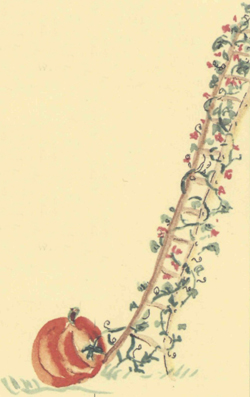
“One dark October night we stole over the fences and through the kudzu thickets into John’s pumpkin patch. We went out into the middle and headed for the biggest pumpkin there. My brother Asa rolled that huge pumpkin over and there, in huge letters carved right in the pumpkin were the words…‘THOU SHALT NOT STEAL’! We were right frightened! We turned over another one…‘HE SEES ALL’! At this we looked up and around, let out screams, and high-tailed it back through the kudzu and home faster than we’d ever travelled before.
“Well, now I’m older and wiser. I know that old John had us figured out pretty early on. Finally, fed up with all our pranks, he had picked out the fairest dozen pumpkins in his patch and had scratched warnings into their soft skins as they were growing. As they grew so did the warnings and by the time we saw them they were darn near as big as billboards.
“Raising my own family, I always let the kids plant a pumpkin patch of their own. They are so comely and lovable, those huge old pumpkins. I love to scratch my grandchildren’s names and their birth dates and sometimes phrases into the pumpkins as they are just starting to put on their growth. The kids love them, and they are always so tickled to have their own namesake pumpkin!”
Why don’t you do this for your children? Give them their own magical pumpkin, named especially for them, and watch their wonder and joy. Recently, I saw a pumpkin patch where a farmer had customized his crop. He took orders in the spring and actually scratched names and addresses or phrases on the pumpkin. For example: WELCOME FRIENDS! These pumpkins last a long time; you could have one sitting on your front porch or doorstep all through the autumn and sometimes even into late spring.
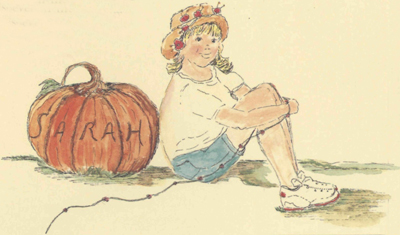
I grew up in a tiny valley surrounded by high, grass-covered hills. Every spring, when the grass got about up to our waists, an excited wave of anticipation swept through the valley. Time for the grass slides—time to start collecting cardboard boxes. Everyone’s trash became fair game. Early on Saturday morning we would rally together with boxes of all sizes. We tore the boxes down, stamped them flat, and then the fun began.
The ascent up the green hillside was slippery and riotous. When we reached the top and looked down, our houses were toy-sized and the people working in their yards looked like bugs. The first ride down was the roughest. We drew straws to determine who would make the “rough run”. I usually lost; in fact, I think I always lost. Could it be because I was the only girl in the gang? My heart would race as I made the season-opening, bumpy ride down the hill. Our whoops and hollers could be heard from one end of the valley to the other as our spring-time sledding party slipped through the sweet, green day.
Yesterday I was talking to some friends about grass slides. Kim Cory remembered racing down Laguna hillsides over a carpet of pungent, wickedly slick eucalyptus leaves. Carolyn Germain described wild runs down Plymouth Avenue in St. Francis Woods in San Francisco in the early 1950s. “And those hills were really terrifyingly steep,” she said. Jeff Prostovich remembered that when spring arrived and sliding began, he had to find numerous excuses for arriving home late with grass stained pants. I wonder if any of us would have the courage to do it now?


When I was a youngster maybe four or five years old, I was terrified to run along the hollyhock trail to Grandmother’s house. I would peek out of our screen door, check to make sure the coast was clear, and then streak through the garden to Grandmother’s back porch. One day I nearly bowled her over as I leapt up the stairs and into her kitchen.
“What on earth is scaring you, dear? she asked. “The dragon monsters,” I replied, with my head bowed in shame. “Do you mean our friend the dragonfly?” she asked. I nodded, ashamed to have finally confessed my biggest fear. “Let me tell you about dragonflies, my dear,” she said. “They are great hunters and while you are playing outside in the garden they are your guardian angels. They patrol the sky above you and snatch insects out of the air before they can bite you or bother you. Indians believed that the dragonflies, which are sometimes called darners, passed back and forth between the water and the air and stitched the rain clouds into the sky. When it rains it is because the dragonflies have decided to rest for a day and they don’t attend to their duties of cloud-darning. On their day of rest the clouds loosen up and drop their rain on the dry earth, awakening sleeping seeds and giving birth to all of the beautiful flowers in our garden. Do you remember the dragonflies ever being out on a rainy day?” I puzzled over that question for a minute and then had to admit that I didn’t.
“So, they’re my guardian angels and they’re protecting me from insects and they put clouds in the sky and they help us have flowers in our garden,” I stated bravely. “Then I won’t ever be afraid of them again.” I turned, walked slowly down the steps, past the iris bed and straight over to the platoon of hollyhocks on the pathway. A pair of jewel-colored dragonflies clattered noisily into each other defending their territories. My heart jumped, but only once, as I turned and waved to Grandmother.
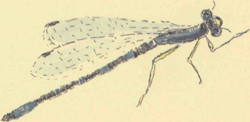
This is a DAMSELFLY. They are smaller than dragonflies and when they rest, they fold back their wings—which is something dragonflies don’t do.
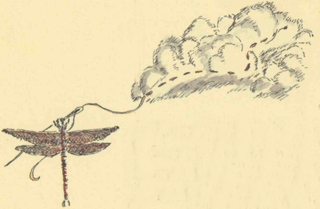
A living rush of light he flew
Tennyson